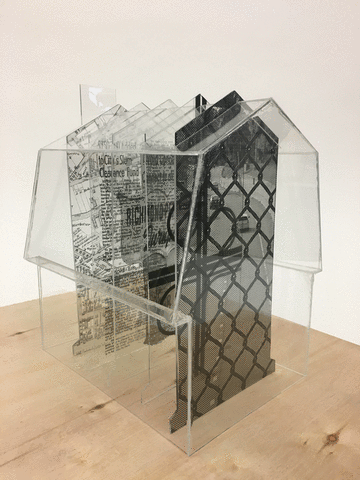
Last week I shared the backstory of my investigation into the Jackson Ward community and the destruction that occurred there during the construction of I-95. All of that research informed my process for making an object of design. With this piece, I seek to give new form to buried and forgotten history, telling the story of the destruction and fragmentation of Jackson Ward.
 The architectural form of the Skipwith-Roper Cottage and the story attached to it become symbolic of the larger issues in the neighborhood after the disruption of the highway. A simplified gambrel-roofed cottage crafted in clear acrylic holds sleeves with layered imagery, iconography, and text. The piece functions as a condensed visual archive of primary source materials and as a narrative timeline. It is ghostly and clear, with all of its interior contents exposed and out in the open. The clarity of the sleeves changes depending on how they are viewed—from the side, the layered images obscure each other in a dissonant mass of texture, with details coming into focus only on closer look. Moving around to a three-quarter view yields more resolution. The sleeves are also movable, an interactive experience alluding to the act of doing archival research.
The architectural form of the Skipwith-Roper Cottage and the story attached to it become symbolic of the larger issues in the neighborhood after the disruption of the highway. A simplified gambrel-roofed cottage crafted in clear acrylic holds sleeves with layered imagery, iconography, and text. The piece functions as a condensed visual archive of primary source materials and as a narrative timeline. It is ghostly and clear, with all of its interior contents exposed and out in the open. The clarity of the sleeves changes depending on how they are viewed—from the side, the layered images obscure each other in a dissonant mass of texture, with details coming into focus only on closer look. Moving around to a three-quarter view yields more resolution. The sleeves are also movable, an interactive experience alluding to the act of doing archival research.
I encountered several challenges and had a few new experiences while making this piece. I used a laser cutter for the first time, and I kept thinking about the intro sequence for Stranger Things. This part of the process was so fun! The laser cutter also helped me avoid trying to cut the acrylic by hand, which would have been difficult, if not impossible to do cleanly.
Before cutting the acrylic, I built a model of the structure using chipboard to get a feel for the form. This helped me determine the best course of action for gluing the acrylic pieces together. I learned quickly that acrylic cement is messy, but it got better as I went along. The next challenge was choosing the content for each sleeve, an exercise in editing. How literal should the story be? I had a wealth of archival imagery and text and on-site documentation to choose from. Ultimately I chose five pieces of content: a map of the neighborhood with the cottage labeled “Roper” from the 1870s (from the Library of Congress archives), several local newspaper clippings on slum clearance and a neighborhood resistance movement in the decade before demolition, a promotional sign for the highway (manipulated from a photo at the Valentine), a simplified overhead view of the Belvedere/I-95 cloverleaf interchange, and a photograph taken from an overpass over the highway during my field research.
During critique I received lots of valuable feedback and points to consider going forward. A few good questions and suggestions are below:
“Does it need a signifier? Where is this specific cottage in all this. We might need more info.”
“Maybe it’s a small dot of color that runs throughout on each of the sleeves.”
“Could this become a site-specific installation?”
“Consider scale and materials. Could it be larger? Made of wood and glass? What about its construction—what if the sliding pieces were horizontal drawers instead of vertical sleeves?”
“Execution gets in the way. The glue splotches are distracting.”
All of this feedback is great, and I do hope to push this piece further. I consider this a first iteration of the concept, with room to experiment on a larger scale piece. I also want to document my research, maybe with a short handmade book.